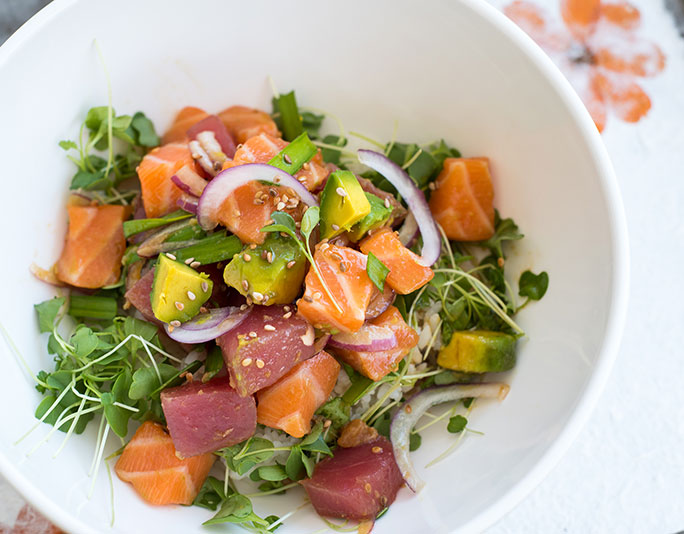Easy Poke in 5 minutes: Poke Recipe with Tuna and Salmon
How often do you eat seafood? When I was growing up in Korea, seafood was served more often than meat at the dinner table. Seafood is a vital part of Korean cuisine due to the fact that the country is surrounded by the ocean on three sides. Also, having a mother who grew up in a small fishing village called, Gangneung, surely impacted the abundance of seafood dishes I grew up eating.
As you can imagine, when I came to America, the lack of variety of seafood and the lack of fresh seafood itself nearly made me move back to Korea. I missed it so much that whenever I went back to Korea to visit, seafood was often what I would eat during my visit.
Then this year, the table turned. A wild, local seafood monger, Captain Ben, started appearing at my local farmer’s market. At first, I thought his seafood was a little pricey, so I only bought a small amount of tuna and ate it as sashimi. That’s all it took! The fish was so fresh, delicious, and the best quality I have found since having moved to America. On top of that, I found out it’s even cost effective when you really break it down. Not to mention, you can eat high quality seafood at home and avoid paying the really high dollars for it at restaurants.
Captain Ben has also passionately taught me about the importance of eating sustainable seafood. So, I’ve been paying more close attention to what I eat and how it affects the environment that I live in.
If you want to find out more info, here are some great resources:
Captain Ben’s Wild Local Seafood Co.
As you may know, wild seafood is a great source of protein. Here is a list of seafood I have tried from Captain Ben’s boat:
Ahi Tuna
King Salmon
Lingcod
Vermillion
Squids
Sardines
Don’t forget, meat closer to the bone has the most flavor and the small guys are really delicious. Try smaller fish, they are delicious and easy on your wallet and environment. If you don’t know what to do with them, ask me. I might make a recipe video for you if you are lucky =).
Eat real, Be Real.
SERVES 2 as an appetizer or 1 as an entree
Total: 5 minutes Active: 5 minutes
Beverage Pairing Tips: SOCAL COOLER (SOJU GINGER HONEY COCKTAIL, 소주 칵테일)
Fresh salmon (sashimi grade), 3oz
Fresh tuna (sashimi grade), 2oz
1 Tbsp. garlic chives, roughly chopped
1 Tbsp. red onion, thinly sliced
1/4 small avocado, 0.5 inch cubes
2 tsp. soy sauce
2 tsp. ponzu sauce
2 tsp. sesame oil
1 ½ tsp. roasted sesame seeds
1/4 tsp. ginger, finely grated
2 pinches kosher salt
Optional garnish:
Kale sprouts
Capelin roe (Masago)
Directions
- Cut the fish into half inch cubes and add these to a small bowl.
- Chop the garlic chives, thinly slice the red onion, and dice the avocado. Add them to the bowl.
- Add the soy sauce, ponzu sauce, sesame oil, sesame seeds, ginger, and kosher salt to the bowl.
- Gently, bring this all together.
- Serve it ‘as is’ as an appetizer or serve over a bed of rice. If over rice, drizzle a little ponzu over the rice to season it, add some fresh kale sprouts, and then top it all off with the scrumptious fish.
*Garnish with capelin roe and a few more sesame seeds for additional texture contrast and nuttiness.
Gopher’s tips:
- Poke keeps in the refrigerator for 2-3 days. Personally, I like it the best when the fish is a little chilled and served over warm rice.
- If you want to learn more about quality soy sauce, check out my blog post: SHOCKING FACTS ABOUT SOY SAUCE: SOY SAUCE WITHOUT SOY
Here are the online shopping resources for the ingredients and the culinary tools I used in this video:
- Soy sauce
- Ponzu sauce
- Zester/Grater


How does Capelin roe (Masago) come? Is this a fresh product?
Hi Jack and Nancy,
I usually buy it frozen at Asian grocery stores. It’s usually in a small plastic container.
I hope this helps.
HG